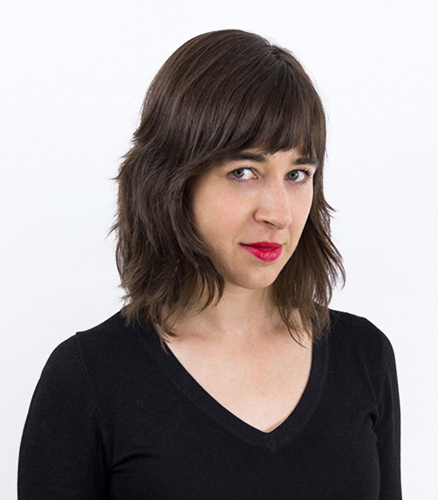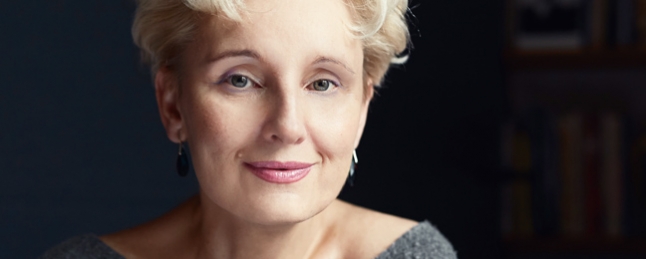Title of the work
Country of the First Edition
Country/countries of popularity
Original Language
First Edition Date
First Edition Details
Piwkowska Anna, ill. Emilka Bojańczyk, Franciszka. Warszawa: Fundacja Zeszytów Literackich, 2014, 180 pp.
ISBN
Awards
2014 – main literary award and the title of the Book of the Year for young adults awarded by the Polish Section of IBBY;
2015 – main award in the category “children’s literature – text and illustrations” in Warsaw Literary Prize contest.
Genre
Bildungsromans (Coming-of-age fiction)
Fiction
Illustrated works
Novels
Target Audience
Young adults (Crossover (Children and young adults – according to the Polish Section of IBBY: 10–16) )
Cover

Courtesy of the Illustrator.
Author of the Entry:
Maciej Skowera, University of Warsaw, mgskowera@gmail.com
Peer-reviewer of the Entry:
Elżbieta Olechowska, University of Warsaw, elzbieta.olechowska@gmail.com
Susan Deacy, University of Roehampton, s.deacy@roehampton.ac.uk
Lisa Maurice, Bar-Ilan University, lisa.maurice@biu.ac.il

Courtesy of Emilka Bojańczyk.
Emilka Bojańczyk
, b. 1979
(Illustrator)
Emilka Bojańczyk is a graphic designer, sculptor, mathematician and a member of the Polish Association of Graphic Designers. She graduated from the Academy of Fine Arts in Warsaw, the University of Warsaw, and the French National Institute for Advanced Studies in Industrial Design in Paris. She is the founder of a graphic design studio Podpunkt [Subpoint] (accessed: July 4, 2018). and its sister company, digital design agency Superskrypt [Superscript]. She has created illustrations for two works of children’s and young adults’ literature: the new edition of a nineteenth-century book Doktor Muchołapski [Doctor Fly-Catcher] (2013, originally published in 1890) by Erazm Majewski, and the contemporary novel Franciszka (2014) by Anna Piwkowska. For her design projects and illustrations, she has received numerous awards in various competitions, such as the “Warsaw Literary Prize,” “European Design Awards,” and “Mobile Trends Awards.”
Sources:
Profile at the otwartakultura.org (accessed: July 4, 2018).
About Us, available at podpunkt.pl (accessed: August 9, 2018).
Bio prepared by Maciej Skowera, University of Warsaw, mgskowera@gmail.com

Courtesy of Wiktor Franko, the author of the photography.
Anna Piwkowska
, b. 1963
(Author)
A writer, literary critic, Polish language and literature teacher. She graduated in Polish philology from the University of Warsaw. Best known as a poet. She debuted in 1980 with poems Jesienne smutki [Autumn Sorrows], Ostatnie dni lata [The Last Days of Summer] and Przedwieczór [Pre-Evening], published in the journal Literatura. She authored nine poetry books, the newest one being Lustrzanka [The Reflex Camera] (2012). A selection of her poems from the years 1990–2015 was published in a volume Wyspa Nieborów [The Island of Nieborów] (2016). Her works in this field were translated into multiple languages. She also authored essays about Russian female writers: Anna Akhmatova and Marina Tsvetaeva, as well as novels: Ślad łyżwy [A Skate Trace] (2007) and Franciszka (2014) – her first (and only, to date) book for the younger audience. For her works, she was granted the Georg Trakl Award, the Kościelski Award, IBBY Poland’s Book of the Year’ prize, and Warsaw Literary Prize. Since 2001, she teaches Polish in the Bednarska School Complex” Her previous occupations include working for such institutions as the Theatre Museum in Warsaw, Na Woli Theatre, Twój Styl Publishing House, and the National Heritage Board of Poland. She currently lives in Warsaw.
Source:
Szałagan, Anna, Anna Piwkowska, available at www.ppibl.ibl.waw.pl (accessed: April 15, 2018).
Bio prepared by Maciej Skowera, University of Warsaw, mgskowera@gmail.com
Translation
Lithuanian: Frančeska, trans. Kazys Uscila, Vilnius: Nieko rimto, 2016.
Slovenian: Frančiška, trans. Staša Pavlović, Ljubljana: Mladinska knjiga Založba, 2016
Summary
In contemporary Warsaw, thirteen-year-old Franciszka learns that her mother, Natasza, taken to the hospital before the plot of the novel begins, is severely ill (later in the book, it turns out that she has leukemia). As the girl has been brought up only by her mother, she must go and live with her grandmother, Ewa, whom she never met. The eccentric woman, called “babsko” [a hag] by Franciszka, does not look like or behave as a grandmother should (according to the protagonist), and their initial relationship is problematic. In the first chapters of the novel, we learn that the girl is very interested in poetry. She even dreams that, in the future, she herself will become a poet. This statement is mocked by Franciszka’s classmate, Fiona, who declares that only men write poetry. In the beginning, the thirteen-year-old believes these words. However, not long after, she learns that there are many female poets, and that she can be one of them. With the grandmother’s subtle help, the girl discovers works by Sappho, Hildegard of Bingen, Halina Poświatowska, Sylvia Plath, Anna Akhmatova, Emily Dickinson, and Wisława Szymborska. This plot thread is interspersed with others: Franciszka’s changing relationship with “the hag” (some chapters, in which the readers learn more about the family’s past, are presented from Ewa’s point of view); her friendship with Soraya, a refugee girl from Rwanda, and with Maciek, a boy who eventually becomes her love interest; the protagonist’s conflicts with her other classmate, Monika; the news from hospital, where her mother is placed. In the end of the book, Franciszka celebrates her fourteenth birthday in Nieborów, a village famous for its aristocratic residence (the Nieborów Palace). This event symbolically shows that the girl is more mature than she was in the beginning of the story – and much happier too: she has managed to become a poet, and even received a special prize at a poetry contest, made friends with her grandmother, and found soulmates in Soraya and Maciek. Although the readers cannot be sure whether Franciszka’s mother has fully recovered or not, it is indicated that there is a possibility she will leave the hospital soon.
Analysis
When Franciszka talks with her friend, Gosia, about poetry, she is not sure who she really is, as she believes that only males can write poetry. The classmate reminds her of Wisława Szymborska, the Polish female writer who, in 1996, won the Nobel Prize in Literature, while the grandmother casually throws out the word “Sappho.” The protagonist, intrigued, goes to the library to check what it means. Guided by a librarian, she reads a book about Sappho and learns that she was a great ancient poet from Lesbos. Franciszka reads that the Greek woman had a daughter named Kleïs, opened a school for girls for and about whom she wrote poems, and was accused – as the book says – of “morbid feelings” towards them (for the main character, however, no love can be called “morbid”). The book also says that Sappho was in love with a man named Phaon and that, because of political intrigues, she was forced to leave Greece and escape to Sicily.* Franciszka is astonished by the story of the poet (the girl cannot believe that such a woman, as she was described by some, could have committed suicide). Soon, the grandmother gives her several yellowed pages with poems, “a letter” from Sappho. The main character of the novel reads the Ode to Aphrodite (Sappho Fragment 1) and a poem about Kleïs, “a beautiful child” with a “form like golden flowers”** (Sappho Fragment 132), and she links these two works to her own experiences. After that, Franciszka is sure that Sappho is her favorite female poet – but, asked about it by “the hag,” she realizes she only knows two of them.
This fragment of the novel can be seen as a first step in Franciszka’s initiation into the world of women’s poetry. Szymborska, a twentieth-century Polish female writer, represents the last link of the chain of poetesses, while Sappho, the metaphorical foundress of women’s writing and “mother” of later girls and women creating poems, is its first link. Between these two figures, as the girl discovers, lies an overwhelmingly great tradition of poetry written by women. The reference to Sappho seems to be particularly important, as this example makes the protagonist aware that women like her, writing poems, are nothing new, since such women lived thousands of years ago and were famous because of their achievements. By introducing her character to subsequent female poets from all around the world, Anna Piwkowska highlights the matrilineal genealogy of writing, which contrasts with the image of poetry as a patriarchal, male-only space. In a way, this corresponds to Clarisa Pinkola Estés’ description of young women gathering the bones of the old ones.*** This metaphorically symbolizes, as Katarzyna Slany explains, “[…] the active memory of experiences inscribed in a matrilineal line,” which serves to indicate that girls need to “[…] search for and reevaluate unwritten [but not only such ones – M. S.] stories of old women in order to interiorize female perspective and specific experience which disclose unnoticed, neglected or silenced facts, contexts, and meaning in women’s history.”**** This also has its reflection in Franciszka’s own life, as she discovers the family “herstory” and becomes a member of a now-reunited triad of women, along with her mother and grandmother, separated and angry with each other for years.
Classical antiquity is referred to in the book for the second time when Soraya, a refugee girl from Rwanda, joins Franciszka’s class. Children, after discussing the myth about Ariadne and Theseus, are told by their teacher to draw the Minotaur. One of them, Monika, suggests that they should portray Soraya instead of the monster. This episode of the novel, by making Monika compare a new student with a mythical creature, serves to indicate that the black girl is seen as the “Other” by some of the protagonist’s classmates. The act of symbolically monstering, or even dehumanizing Soraya, is the beginning of the process of alienating her. Franciszka and Maciek oppose these actions and make friends with this character, who later becomes more and more integrated into the class, which in turn may be interpreted as a form of accepting the “Other” by the community. Therefore, Piwkowska’s book is not only a novel about women and poetry, but also a one which supports multiculturalism and, at the same time, condemns racist behavior.
* Note that not everything that Franciszka reads about is confirmed by scholars.
** Sappho Fragment 132, as translated in: Diane J. Rayor, André Lardinois, Sappho: A New Translation of the Complete Works, New York: Cambridge University Press, 2014, 78.
*** See: Clarissa Pinkola Estés, Women Who Run With the Wolves: Myths and Stories of the Wild Woman Archetype, New York: Ballantine Books, 1992, 38.
**** Katarzyna Slany, “Rutka Joanny Fabickiej jako przykład postpamięciowej literatury dla dzieci” [Rutka by Joanna Fabicka as an Example of Post-Memory Children’s Literature], Maska 3(35) (2017): 81–94, 83. Quotation translated by Maciej Skowera. In the cited paper, Slany uses Estés’ concept when analyzing Joanna Fabicka’s novel Rutka (2016).
Further Reading
Borowski, Dominik, “Trudna sytuacja jako test dojrzałości (Franciszka Anny Piwkowskiej, Most nad Missisipi Ewy Przybylskiej)” [A Difficult Situation as a Test of Maturity (Franciszka by Anna Piwkowska, Bridgeover Missisipi by Ewa Przybylska)] in Światy dzieciństwa. Infantylizacje w literaturze i kulturze [Children’s Worlds: Infantilizations in Literature and Culture], Małgorzata Chrobak and Katarzyna Wądolny-Tatar, eds., Kraków: Universitas, 2016, 377–391.
Pekaniec, Anna, “Poezja, która daje wolność. O wyobraźni (nie tylko) poetyckiej we Franciszce Anny Piwkowskiej” [Poetry that Gives Freedom: Imagination (Not Only Poetic) in Anna Piwkowska’s Franciszka] in Wolność i wyobraźnia w literaturze dziecięcej [Freedom and Imagination in Children’s Literature], Anna Czabanowska-Wróbel and Marta Kotkowska, eds., Kraków: Wydawnictwo Uniwersytetu Jagiellońskiego, 2017, 83–94.
Skowera, Maciej, „Koniec z Potterem, czas na Gombrowicza! O Franciszce Anny Piwkowskiej” [Finish with Potter, Read Gombrowicz! On Franciszka by Anna Piwkowska], Kultura Liberalna 39(299) (2014), available at kulturaliberalna.pl(accessed: April 15, 2018).
Addenda

The illustration (p. 25) showing Sappho escaping Greece to Sicily, courtesy of Emilka Bojańczyk, illustrator.


